Lab Safety Manual - UCLA - Environment, Health & Safety
Lab Safety Manual - UCLA - Environment, Health & Safety
Lab Safety Manual - UCLA - Environment, Health & Safety
You also want an ePaper? Increase the reach of your titles
YUMPU automatically turns print PDFs into web optimized ePapers that Google loves.
of the nine readings must be at least 100 linear feet per minute (lfm) with a minimum of 70 lfm for any<br />
measurement. The average face velocity should not exceed 160 lfm.<br />
Each fume hood must be equipped with at least one type of continuous quantitative monitoring<br />
device designed to provide the user with current information on the operational status of the hood.<br />
Many hoods also have motion sensors to determine when they are not in active use. These sensors<br />
will reduce the fume hood‟s air flow as part of the campus‟ energy savings effort. When hazardous<br />
materials are in a fume hood, but it is not under active use (e.g., during an unattended reaction or<br />
experiment), the sash should be closed. Fume hoods are not designed for storage of hazardous<br />
materials.<br />
Routine maintenance and repairs of fume hoods are conducted by Facilities Management. Hood<br />
users may route requests for hood repair directly to Facilities via Facilities Service Requests (FSR).<br />
Make sure to indicate that the FSR has been “generated as a result of a health and safety deficiency”<br />
and mark it “urgent” in order to expedite processing. EH&S does not initiate maintenance but will<br />
coordinate with Facilities Management to ensure that it is completed. Upon reported completion by<br />
Facilities, EH&S will re-inspect the fume hood following maintenance or repairs.<br />
General Rules for Fume Hood Use<br />
The following general rules should be followed when using laboratory hoods:<br />
1. Fume hoods should not be used for work involving hazardous substances unless they have a<br />
certification label that confirms certification has occurred within the past year<br />
2. Always keep hazardous chemicals >6 inches behind the plane of the sash<br />
3. Never put your head inside an operating laboratory hood. The plane of the sash is the barrier<br />
between contaminated and uncontaminated air<br />
4. Work with the hood sash in the lowest practical position. The sash acts as a physical barrier<br />
in the event of an accident. Keep the sash closed when not conducting work in the hood<br />
5. Do not clutter your hood with unnecessary bottles or equipment. Keep it clean and clear. Only<br />
materials actively in use should be in the hood<br />
6. Do not make any modifications to hoods, duct work, or the exhaust system without first<br />
contacting the EH&S office via the EH&S Hotline at 310-825-9797<br />
7. Do not use large equipment in laboratory hoods unless the hood is dedicated for this purpose, as<br />
large obstructions can change the airflow patterns and render the hood unsafe<br />
8. Shut your sash! For energy efficiency, make sure to shut your sash when the hood is not in use<br />
<strong>Lab</strong>oratory fume hoods are one of the most important pieces of equipment used to protect laboratory<br />
and other workers from exposure to hazardous chemicals. Chemical fume hoods should be<br />
inspected upon installation, renovation, when a deficiency is reported, or a change has been<br />
made to the operating characteristics of the hood. Since fume hoods used for regulated<br />
carcinogens (as listed in the <strong>UCLA</strong> Particularly Hazardous Substances Policy:<br />
http://www.adminpolicies.ucla.edu/app/Default.aspx?&id=907) have additional requirements, such<br />
as increased face velocity (average of 100-150 lfm, with no measurement less than 100 lfm),<br />
contact the EH&S Hotline at 310-825-9797 if the intended use changes.<br />
Chemical Hygiene Plan 4-3 January 2013
















